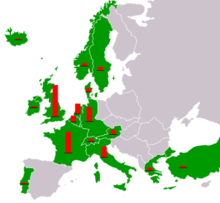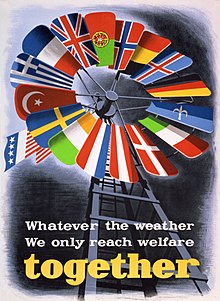Marshallplanen



Marshallplanen (engelsk European Recovery Program, ERP) var et amerikansk hjælpeprogram rettet mod Europa, som blev sat i gang efter 2. verdenskrig. Initiativet fik navn efter den amerikanske udenrigsminister George Marshall, og var i stor udstrækning udarbejdet af embedsmænd i udenrigsministeriet, specielt William L. Clayton og George F. Kennan.
Planen var en opfølgning af Trumandoktrinen med støtte af økonomiske midler. USA's politikere havde den opfattelse, at økonomisk krise gav grobund for kommunisme. Et stærkt, samlet og genopbygget Vesteuropa ville derimod være en militær modvægt mod Sovjetunionen, og svække kommunistpartiernes indflydelse i de enkelte lande. Ydermere var tanken bag Marshallhjælpen, at USA selv kunne undgå en økonomisk krise, da de var afhængig af at handle hos deres europæiske handelspartnere. Der var altså såkaldt interdependens mellem Europa og USA.
Derfor tilbød USA's udenrigsminister George Marshall i 1947 de europæiske lande økonomisk hjælp til genopbygningen efter krigen. Europa havde store problemer efter verdenskrigen: Produktion og handel lå i ruiner. Og i foråret 1947 var det tydeligt, at de vesteuropæiske landes dollarreserver var i færd med at tømmes. Modtagerlandene skulle til gengæld samles i et økonomisk samarbejde, OEEC, Organisation for European Economic Co-operation, i 1948. Det blev i 1961 udvidet til også at omfatte ikke-europæiske lande, og fik navnet OECD, Organisation for Economic Co-operation and Development.
Som led i problemerne omkring delingen af Tyskland, fik Sovjetunionen og de østeuropæiske lande også tilbuddet, men takkede nej af frygt for at USA ville få stor indflydelse på de pågældende lande. Afslaget betød et markant forskel mellem øst og vest.
| Land | 1948/49 (mio. $) | 1949/50 (mio.$) | 1950/51 (mio. $) | I ALT (mio.$) |
|---|---|---|---|---|
| Belgien og Luxembourg | 195 | 222 | 360 | 777 |
| Danmark | 103 | 87 | 195 | 385 |
| Frankrig | 1.085 | 691 | 520 | 2.296 |
| Grækenland | 175 | 156 | 45 | 366 |
| Holland | 471 | 302 | 355 | 1.128 |
| Irland | 88 | 45 | 0 | 133 |
| Island | 6 | 22 | 15 | 43 |
| Italien og Trieste | 594 | 405 | 205 | 1.204 |
| Norge | 82 | 90 | 200 | 372 |
| Portugal | 0 | 0 | 70 | 70 |
| Schweiz | 0 | 0 | 250 | 250 |
| Sverige | 39 | 48 | 260 | 347 |
| Storbritannien | 1.316 | 921 | 1.060 | 3.297 |
| Tyrkiet | 28 | 59 | 50 | 137 |
| Vesttyskland | 510 | 438 | 500 | 1.448 |
| Østrig | 232 | 166 | 70 | 468 |
| Total | 4.924 | 3.652 | 4.155 | 12.731 |
Se også
Litteratur
- Danmarks Nationalbank (november 1999). Marshall-hjælpen og Den Europæiske Betalingsunion (PDF). København: Danmarks Nationalbank. ISBN 87-87251-18-3.
| ||||||||||||||||||||||
|
Medier brugt på denne side
One of a number of posters created by the Economic Cooperation Administration, an agency of the U.S. government, to sell the Marshall Plan in Europe. Includes versions of the flags of those Western European countries that received aid under the Marshall Plan (clockwise from top: Portugal, Norway, Belgium, Iceland, West Germany, the Free Territory of Trieste (with a blue background instead of red, as blue is the official the color of the United Nations), Italy, Denmark, Austria, the Netherlands, Ireland, Sweden, Turkey, Greece, France and the United Kingdom). Poster does not explicitly depict Luxembourg (whose flag is very similar to the Dutch flag), which did receive some aid.
Logo used on aid delivered to European countries during the Marshall Plan, starting about 1948.
The labeling was deemed necessary when Congress became concerned that the Soviet Union was taking credit for the poorly-marked U.S. foreign aid donations to European countries. The shield was adapted from the Great Seal of the United States, and the slogan was translated into the languages of the recipient countries.
The slogan became obsolete when military aid was added to the economic program, and when some Near East and Asian countries became aid recipients under President Truman’s Point IV Program. In 1951, the slogan was changed to “Strength for the Free World from the United States of America.”
The logo was used until 1953, when the Mutual Security Agency (a successor to the Marshall Plan programs) revised it. The logo for the United States Agency for International Development (the current incarnation of the same programs) is descended from this logo, and those of intermediate agencies.
For more information, see USAID's branding guidelines, in particular the Graphic Standards Manual.

